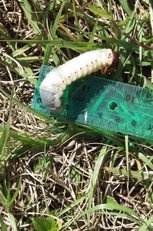 So much happens in the world. My own lawn -- a flat, sandy square with sparse, seasonal grass -- is rich with drama. Lizards defending their turf, ant-lions excavating their circular traps, spiders trapeze-ing around, the odd turtle cruising through. This week, when the sun was out, I happened upon an enormous grub crawling out of the ground. Pale, translucent, squirmy, better than two inches long. I wish I could un-see it. Why was it on the move in the middle of winter? Scientific curiosity muscled aside by revulsion, I flicked it onto the shed roof so that a mockingbird might make a meal of it. I admit the birds' drama interests me most: the chirpy purple martins who return each year (so early! I spotted the first scouts in January), the pair of owls who invaded and occupied a squirrel's nest last year, the mob of raucous crows bedeviling the owls. Crossing the sandy lawn, I spot a mess of feathers by the mailbox: a single flight-feather, big handful of curled coverts, and drifting snowflakes of pale down. The scene is bloodless, but it must have been a massacre. A Cooper's hawk probably, taking a mourning dove at speed. Not to brood on the "nature red in tooth and claw"* character of wildlife, but there's this: What manner of creature stuffed this narrow gap between two channel-markers with the dismembered wings of seagulls? A rogue osprey? An angry human? What other bird-of-prey hunts the open bay?
Was this -- like the fried chicken bones left in a pile along the sea-wall -- the remains of an alfresco picnic? Wings, after all, not being the most nutritious bit of bird? Did someone or somebird perform the dismemberment for vengeance? A bird-feud, a bird-vendetta? Were the wings left as warning? Surely the owners of these wings did not just keel over and land there, did they? I've never seen it a second time, but the mystery haunts me. (*"Nature red in tooth and claw" is a quotation from Tennyson's "In Memorium," a long meditation on doubt and the afterlife.)
7 Comments
cathmason
2/4/2014 12:08:49 pm
My teeth are on edge. Tooth and claw indeed. Deadeye writing, Amy
Reply
Amy
2/5/2014 12:38:51 am
Oh go on!
Reply
Kate
2/9/2014 09:52:59 am
What a macabre vision! I am more than a little creeped out by that... Thank you (I think?) for sharing!
Reply
Amy
2/10/2014 01:14:45 am
You're welcome, Kate!
Reply
Kate
2/10/2014 09:43:14 am
I work with quite a few seabird researchers... I will ask around and see if I can get some answers.
Kate
2/10/2014 02:34:22 pm
So.... I got some answers, but I'm not sure you're going to want to know. It's not a seabird behavior, I'll leave it at that unless you want more.
Reply
Amy
2/10/2014 03:26:30 pm
Erg. Going from gruesome speculation to awful truth? I do want to know, but perhaps offline -- will you drop me an e-mail?
Reply
Leave a Reply. |
About the Blog
A lot of ground gets covered on this blog -- from sailboat racing to book suggestions to plain old piffle. FollowTrying to keep track? Follow me on Facebook or Twitter or if you use an aggregator, click the RSS option below.
Old school? Sign up for the newsletter and I'll shoot you a short e-mail when there's something new.
Archives
June 2024
Categories
All
|
 RSS Feed
RSS Feed
